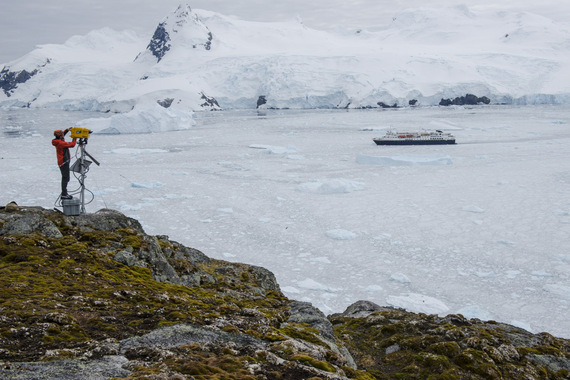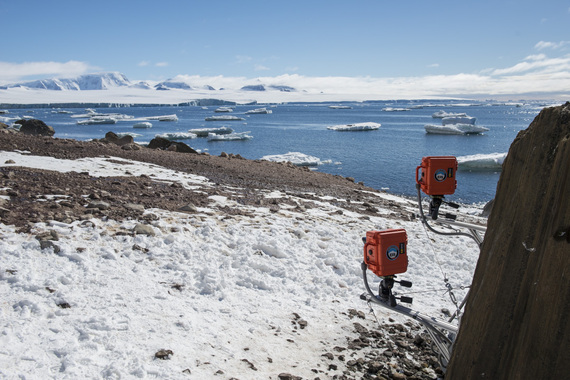By Stephen Nowland, Staff Photographer for Earth Vision Trust and the Extreme Ice Survey
Photo Courtesy of Extreme Ice Survey ©Earth Vision Trust.
The Antarctic Peninsula separates the warm maritime climate of the Bellingshausen Sea to the west and the cold, dry continental climate of the Weddell Sea to the east. Thus far, we have been traveling and working along the western edge, but this morning, we crossed the tip and passed into a different world. For one, there is a notable nip to the air and a jacket is requisite for even a quick foray to the ship deck. Second, our idea of icebergs now takes on a whole new meaning, as enormous tabular icebergs now dominate the landscape. These floating fortresses often dwarf our ship and come in beautiful, strange shapes, sculpted by the interplay of water and air.
Our first stop, Brown Bluff, on the northeastern tip of the Antarctic Peninsula, is a penguin paradise. Slick rounded stones and a gentle grade allow the penguins easy access to the ocean and their abundant food supply. As we pull up to the shore, beautiful blue-white icebergs rock gently in the relatively calm, shallow waters of the bay. Gentoo penguins surround us as we walk down the beach. These gentle, docile creatures waddle to and fro, enjoying the fading moments of the Antarctic summer. The penguins here are in various stages of molting, pushing out their down feathers in preparation for the long, cold, Antarctic winter ahead. For the first time in the history of the Extreme Ice Survey, we will be installing a camera, not to photograph a calving face of a glacier, but to photograph another face, or to be precise, many, many faces. These cameras will watch a large Adélie penguin colony, or at least we hope it will. For now, we must be happy with a few stragglers and an odorous landscape of guano and rocks.
Photo Courtesy of Extreme Ice Survey ©Earth Vision Trust.
The Adélies, who are now out at sea, will return around September, filling this landscape with thousands of nesting pairs. Adélie penguins are feeling the impacts of the warming climate acutely. Increased temperatures, coupled with decreased sea ice and increased snowfall are acting in concert to drive these penguins further south along the peninsula. Over the next few years, these cameras will capture so much: the land, the sea, the wildlife, the ice, as well as, the coming and going of seasons, the colony as it grows and shrinks then grows again. No doubt there will be many other surprises that will reveal themselves with time, but until then, we must wait. This marks the sixth and seventh cameras deployed since leaving Ushuaia, and from our standpoint, one of the more aesthetically pleasing installation sites.
The cameras at Brown Bluff come on the heels of another successful camera installation at Cierva Cove. The jaw-dropping beauty of Cierva is hard to translate into words. Here, skua birds, numbering in the hundreds soar overhead, sometimes diving and swooping close when we cross some unseen boundary around their nests. We respect their claim and find alternate routes to get to our final destination, which is a rock outcropping overlooking the glacier and the sea. From our perch high on the cliffs overlooking the calving face of the Cierva Cove glacier, these cameras will record time and movement of this dramatic scene; in the process creating a visual preservation of what this glacier is now, and what it will transform into in the future.
The weather on the peninsula has been forgiving to us and it's hard to believe we made it through the last few days without a dark sky or stiff breeze. Tonight, we turn our attention further north to South Georgia Island, again faced with the potentially volatile waters of the southern ocean. The Captain says it's looking a bit gusty.
Visit EarthVisionTrust.org to discover how the images gathered by the Extreme Ice Survey network of time-lapse cameras clearly demonstrate the effects of Climate Change.
Photo Courtesy of Extreme Ice Survey ©Earth Vision Trust.


